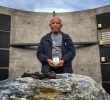The winning private investor, according to the PMDC’s terms of reference (TOR), would mine the site through a joint operating agreement with the PMDC for 25 years. The contract is renewable for another 25 years. The bid requires from investors, a bank-approved credit line of at least 500 million pesos among others and a minimum bidding rate of no less than 300 million pesos.
Manila-based environment group Kalikasan said on June 9 that of the four prequalified bidders, the Philex Mining Corp would most likely win. Philex is the country’s largest mining firm which figured in a mining disaster in Northern Luzon where it operates Benguet mines. Other firms prequalified to bid included the APC Group Inc./South China Resources Inc., the Carrascal Nickel Corporation and the construction firm FF Cruz & Co. Inc.
The winning bidder will tap the area underneath the 729-hectare populated gold-rush site which largely remained untapped at present.
But to Elijorde’s wife, Dailen, 43, the project site sits right below where her family’s and the villagers’ houses stand. It is also below the designated area for small-scale miners who have made a living here since the early 80s.
Daileen’s family has lived and worked here for 25 years. She is worried that they would have nowhere else to go once a large-scale mining company operates here. “We will be forced to vacate our homes and our livelihood because it would already be very unsafe for us,” Dailen told Davao Today.

THE CHILDREN OF MT. DIWATA line up in the school ground totally unaware of the growing tension. (davaotoday.com photo by Jose Hernani)
On the PMDC’s May 13 bid bulletin, the government washed its hands off any responsibility or “liability” on the winning bidder’s mining operations. The government has placed the accountability of what will happen to the site solely on the winning bidder.
In a village assembly before the first PMDC-scheduled bidding on May 14, Mt. Diwata villagers opposed the plan to bid the area out to large mining firms, citing the grave hazards that could result. They also rejected the annual 20 million pesos social development projects dangled to them from the winning bidders.
“All we want is our safety and our livelihood,” Dailen said.
‘Better Option’
“The government and the existing minders should develop the area,” village councilor Ismael Herbolingo said in an April news conference.
Small-scale miners had been “straight-jacketed” to mine only the designated 729-hectare gold rush site in the above 600-meter above-sea-level elevation. The small-scale mining area being managed by another government-controlled agency, the Natural Resource Development Corporation, has been almost completely mined-out.
“We’re already lucky if we get one gram of gold ore per sack. It was so unlike before when we get high-grade or about five grams of gold ore per sack,” Velasco said.
In the bidding process, small-time miners have no match against big-time bidders.
Environment group Panalipdan said Diwalwal’s problems would not go away if government would not reverse its policy of exporting minerals.
“Government should take over the control of the industry, regulate and plan its usage,” said Francis Morales, spokesperson of Panalipdan in Southern Mindanao.
”This extractive policy only benefits the big capitalist nations such as US, China, Canada and Australia and the corporations that have anchored their economic profits and industrial mineral needs on our own resources.”
“Instead of selling Diwalwal, the government should nationalize Diwalwal,” Morales said. “Our minerals should be used for the needs of the people.”( Daisy C. Gonzales, Marilou Aguirre-Tuburan & Jose B. Hernani/davaotoday.com)










